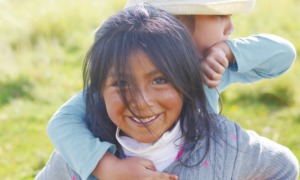
Luis Sánchez Saturno/The New Mexican file photo
Cabinet Secretary for Public Education Ryan Stewart has discussed how education can empower youth to expunge generational racism.
The COVID-19 pandemic and the shift to online learning have exposed a number of unexpected and difficult educational achievement gaps for New Mexico public school students. The New Mexico Public Education Department (PED) says that the tiny Sandoval County village of Cuba, a rural community with an estimated population of 735, seamlessly shifted from in-person classroom instruction to distance learning. The Cuba Independent School District, which educates students living in the surrounding pueblos, had received a grant to upgrade its technology infrastructure, allowing for a mostly headache-free transition for area students and teachers, said Nancy Martira, PED director of communications.
Meanwhile, Gallup-McKinley County Schools (GMCS), which predominantly educates Navajo students, has struggled since New Mexico’s schools were ordered to close in mid-March. Due to a dearth of technology in the area, GMCS has been sending educational “paper-pencil packets” through the mail to a majority of its approximately 11,000 K-12 students.
“The only way we can equitably deliver education is mailing packets of information back and forth to students,” said GMCS Superintendent Mike Hyatt. “Because how do you treat one student that has all of the technology in the world and another student who you don’t even have an accurate phone number for? How do you have equity in that environment? It’s a very difficult position.”
PED has scrambled to juggle pandemic-spawned educational disruptions for teachers and the estimated 330,000 students enrolled in the state’s public K-12 institutions. One of the department’s biggest challenges is making sure at-risk students, including foster youth and young people experiencing homelessness, have equal access to technology and online education compared to their peers.
As of March, 9,058 kids enrolled in New Mexico public education (or approximately 2.7% of the total pre-K-12 student population) met the federal definition of homelessness during the 2019-20 school year. According to Dana Malone, PED’s state education coordinator for homeless children and youth, the state’s top six greatest concentrations of homeless youth who attend public schools are in Albuquerque, Santa Fe, Las Cruces, Los Lunas, Carlsbad and Gallup.
[Related: Gallup Schools Hope For CARES Funding for Tech Purchases]
[Related: State Outreach Helping Aged-out Foster Youth Amid Anxiety About Lost Oil Field Jobs]
[Related: Pandemic Accelerated Rollout of Extended Foster Care ‘in Really Good Way’]
[Related: Mesilla Valley CASA Helping Youth Past CYFD Age Cutoff]
PED has navigated the pandemic in creative ways, such as conducting surveys with youth experiencing homelessness in order to meet their greatest needs. The state education department has also asked bus drivers to deliver food and educational materials via their normal routes.
The agency’s ENGAGE New Mexico program has helped students transition from a traditional classroom to home learning by giving students an academic coach free of charge. Additionally, PED reaffirmed its educational commitment to the state’s marginalized students and families after the deaths of George Floyd in Minneapolis, Ahmaud Arbery in Georgia and Breonna Taylor in Kentucky.
Cabinet Secretary for Public Education Ryan Stewart, the first black person to lead the Santa Fe-based agency, denounced the brutalities against people of color and discussed how education can empower youth to expunge generational racism in a June 2 public statement.
Students without stable homes
But PED is facing criticism for allegedly snubbing homeless students when schools closed for in-person instruction and in PED’s recently released learning plan for the 2020-21 school year, says Jennifer Ramo, executive director of New Mexico Appleseed, a Santa Fe nonprofit that advocates for low-income youth and families.
“Homeless children are more at risk of educational failure than nearly any other population. That is why they have special legal protection under federal law,” Ramo said. “Yet, when we examined the district-level continuous learning plans to address those risks, they were largely devoid of substance. Then, when we combed through PED’s reentry plan, our hearts just sank. There was almost nothing in there about children who are doubled up, in a shelter, couch surfing or at a motel.
“There have to be state-level directives that require schools to guarantee equal access to an education with consequences for noncompliance,” she said. “Otherwise, these kids will lose more than they could ever make up.”
The biggest need for students experiencing homelessness during the coronavirus isn’t a stable living situation, which ranked seventh in a recent PED survey, but rather mobile hotspots and internet access, Malone said. The technology gap for homeless youth makes it nearly impossible for them to catch up on schoolwork, she said.
“Every time you move, you lose part of your education and fall behind by about three to six months,” Malone said. “If you move two or three times in one year, then they start to think, ‘What’s the point of even going to school? I’m so far behind that I can’t catch up.’”
Homeless liaisons track down students
According to PED, there are 143 homeless education programs throughout New Mexico’s 89 public school districts as well as every state charter school. Homeless liaisons are assigned to each school district and act as case managers, identifying and linking youth and families to school and community resources.
The New Mexico educational system identifies homeless students under the U.S. Department of Education’s classification of youth homelessness. The McKinney-Vento Homeless Assistance Act definition includes kids who are crashing on couches, sleeping in a vehicle or constantly shuffling from one place or another.
Ultimately, Malone said, it’s up to each homeless liaison, school district, teacher and staff member to know the legal definition of youth homelessness and the corresponding educational rights for the student population who are experiencing housing challenges in New Mexico.
“The social and emotional piece of being homeless is just as heavy as not having a house or not being able to follow through with your education because you’re lacking basic necessities,” she said.
As a result of the coronavirus outbreak, PED, together with the national Graduation Alliance, created the ENGAGE New Mexico project, which took the burden off teachers to try to contact students who weren’t logging into virtual classrooms.
“We had a dedicated team whose whole job was to try to make contact with these families and students and understand what the situation was, what challenges they were facing and what kind of support and encouragement they needed,” Martira said. The project ended June 19.
Along with technology deserts, PED’s homeless liaisons found that students also lack devices such as laptops, phones and tablets, homework assistance from a parent or adult, and emotional and mental health services.
“This is really stressing our folks out,” Malone said. “It has definitely brought out more domestic violence and substance abuse and the social ills that go along with that.”
A recently released New Mexico Legislative Finance Committee newsletter concluded that some students could lose up to a full academic year due to school closures, partially because PED directed school districts to teach students previously learned material rather than new lesson plans. A McKinsey & Company report shows that black and Hispanic students might fall even further behind as a result of a shift in distance learning due to the coronavirus.
PED says that they’ve stepped up their efforts to contact kids and families at least a couple of times a week if not every day. “We give the kids time and space to talk about what they’re feeling, both in a one-on-one situation and with their peers so they can hear from each other how they’re feeling,” Martira said.
Other educators have gone above and beyond once students have logged out of daytime virtual classrooms. A librarian with Albuquerque Public Schools (APS) has read bedtime stories to kids and families twice a week and an APS teacher has held a number of cooking classes for children. “Our educators have stepped up in amazing ways,” Martira said.
School finances
After schools closed for the spring semester, PED started providing breakfast and lunch to every young New Mexican aged 1 to 18, even for children who aren’t enrolled in school. PED estimates that they’ve served over seven million meals since mid-March via its grab-and-go meal sites as well as through the bus drivers who have delivered food to rural areas.
Additionally, the U.S. Department of Agriculture awarded $97.8 million to the state for a pandemic electronic benefit transfer program, which is administered by PED and the New Mexico Human Services Department. Students on the Supplemental Nutrition Assistance Program (SNAP) as well as Medicaid are getting an additional $399 benefit through this month.
The future of public school financing is murky. Gov. Michelle Lujan Grisham, ahead of the special session of the New Mexico Legislature that ran from June 18 to Monday, said she didn’t anticipate significant monetary cuts to public schools.
However, state lawmakers, in order to deal with a $2 billion budget shortfall brought on by the pandemic, passed a solvency budget that reduced a pay raise for teachers from 4% to 1% and trimmed $20 million from the Early Childhood Trust Fund that was created during the 2020 regular session.
On Tuesday, PED announced a hybrid model for the beginning of the 2021-22 school year, where students will rotate between in-person classrooms and online learning from home beginning Aug. 3.
Malone is especially concerned about kids who are in shaky living situations.
“If we think about students who are homeless, everybody is prepared to give them a backpack and school supplies, but I promise you that that’s not going to help them graduate,” she said. “They have so many other needs that are heavy for them. If they don’t have the proper interventions or supports, they’re not going to be academically successful.”
PED is working together with other state agencies, she said.
“I feel the positive thing that has come out of all of this is our eyes are wide open to what is happening,” she said. “There are so many people struggling right now and though school can’t fix everything, we can definitely help in a lot of different ways.”
This story has been updated.
This story is part of a Youth Today project on foster care in New Mexico. It’s made possible in part by the May and Stanley Smith Charitable Trust. Youth Today is solely responsible for the content and maintains editorial independence.





























